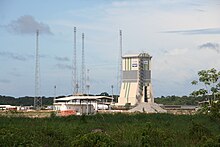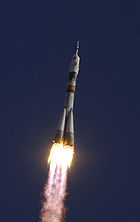Ensemble de Lancement Soyouz
 | |||||||||||||
 | |||||||||||||
| Launch site | Guiana Space Centre | ||||||||||||
|---|---|---|---|---|---|---|---|---|---|---|---|---|---|
| Time zone | UTC−03 (GFT) | ||||||||||||
| Short name | ELS | ||||||||||||
| Operator | Arianespace · ESA | ||||||||||||
| |||||||||||||
Ensemble de Lancement Soyouz (ELS, lit. 'Soyuz Launch Complex') is a launch complex at the Guiana Space Centre in French Guiana. Currently inactive, the complex was first used in October 2011 in support of the Soyuz-ST rocket and the Soyuz at the Guiana Space Centre programme.[1]
History
[edit]The first launch to use the complex occurred on 21 October 2011, when a Soyuz ST-B launched the first two Galileo In Orbit Validation spacecraft.[2]
The site's equatorial latitude allows a greater payload mass to be delivered into geosynchronous transfer orbit compared to existing Soyuz launch facilities at the Baikonur Cosmodrome in Kazakhstan.[2]
ELS is fifteen kilometres north-west of the launch facilities used by Ariane rockets.
It consists of a single launch pad, with a horizontal assembly and processing facility, or MIK, located 700 metres away. As with the Soyuz launch complexes at Baikonur and Plesetsk, the pad is connected to the MIK by means of a wide gauge railway, along which the rocket is transported before erection at the pad.
Unlike other Soyuz launch complexes, the pad features a mobile service tower, where the payload is integrated when the rocket is in the vertical position; at Baikonur and Plesetsk the payload is horizontally integrated in the MIK before the rocket is moved to the pad.[3] The tower shrouds the rocket during integration, but is moved back to a safe distance (again on rails) prior to launch.
ELS also differs in having a fixed launch mount, rather than one which can be rotated,[4] meaning that the rocket may need to execute a roll manoeuvre during its ascent to orbit. Earlier rockets in the R-7 family were incapable of rolling, so their launch complexes were built to allow launch azimuth to be adjusted before launch.
In 2015 after the quantity of payload orders requiring fuelling at the launch complex S3B site had been identified as a possible bottleneck in flight operations FCube, a new clean room fuelling facility dedicated to the Fregat upper stage and potentially additional small satellite payloads was built which will cut fuelling times from five weeks to as little as one.[5]
On 26 February 2022, Roscosmos announced that it was suspending operations at ELS as a reaction to International Sanctions following the Russo-Ukrainian War.[6] According to Stephane Israel, CEO of Arianespace, "there will no longer be Soyuz launches" from the Guiana Space Center.[7]
Launch history
[edit]| Flight | Date | Time (UTC) | Configuration | Outcome | Payload | Remarks |
|---|---|---|---|---|---|---|
| VS01 | 21 October 2011 | 10:30 | Soyuz-STB/Fregat | Success[8] | Galileo IOV-1 | Navigation satellites |
| VS02 | 17 December 2011 | 02:03 | Soyuz-STA/Fregat | Success[9] | Pleiades 1A SSOT ELISA (4 satellites) |
Imaging Satellite Earth observation satellite for Chile Electronic Intelligence Satellites |
| VS03 | 12 October 2012 | 18:15 | Soyuz-STB/Fregat | Success[10] | Galileo IOV-2 | Navigation satellites |
| VS04 | 2 December 2012 | 02:02 | Soyuz-STA/Fregat | Success[11] | Pleiades 1B | Imaging Satellite |
| VS05 | 25 June 2013 | 19:27 | Soyuz-STB/Fregat | Success[12] | O3b F1 | Low Earth orbit communication satellites |
| VS06 | 19 December 2013 | 09:12 | Soyuz-STB/Fregat | Success[13] | Gaia | Lissajous orbit – Space observatory |
| VS07 | 3 April 2014 | 21:02 | Soyuz-STA/Fregat | Success[14] | Sentinel-1A | Sun-synchronous orbit – Earth observation |
| VS08 | 10 July 2014 | 18:55 | Soyuz-STB/Fregat | Success[15] | O3b F2 | Low Earth orbit communication satellites |
| VS09 | 22 August 2014 | 12:27 | Soyuz-STB/Fregat | Partial failure[16] | Galileo FOC-1 | Navigation satellites |
| VS10 | 18 December 2014 | 18:37 | Soyuz-STB/Fregat | Success[17] | O3b F3 | Low Earth orbit communication satellites |
| VS11 | 27 March 2015 | 21:46 | Soyuz-STB/Fregat | Success[18] | Galileo FOC-2 | Navigation satellites |
| VS12 | 11 September 2015 | 02:08 | Soyuz-STB/Fregat | Success[19] | Galileo FOC-3 | Navigation satellites |
| VS13 | 17 December 2015 | 11:51 | Soyuz-STB/Fregat | Success[20] | Galileo FOC-4 | Navigation satellites |
| VS14 | 25 April 2016 | 21:02 | Soyuz-STA/Fregat | Success | Sentinel-1B | Sun-synchronous orbit – Earth observation |
| VS15 | 24 May 2016 | 08:48 | Soyuz-STB/Fregat | Success | Galileo FOC-5 | Navigation satellites |
| VS16 | 28 January 2017 | 01:03 | Soyuz-STB/Fregat | Success | Hispasat 36W-1 | Geostationary communication satellite |
| VS17 | 18 May 2017 | 11:55 | Soyuz-STA/Fregat | Success | SES 15 | Geostationary communication satellite |
| VS18 | 9 March 2018 | 17:10 | Soyuz-STB/Fregat-MT | Success | O3b F4 | Four MEO communication satellites |
| VS19 | 7 November 2018 | 3:47 | Soyuz-STB/Fregat-M | Success | MetOp-C | Polar-orbiting meteorological satellite |
| VS20 | 19 December 2018 | 16:37 | Soyuz-STA/Fregat-M | Success | CSO-1 | French military Earth observation satellite |
| VS21 | 27 February 2019 | 21:37 | Soyuz-STB/Fregat-M | Success | OneWeb F6 | Six test satellites for the OneWeb constellation |
| VS22 | 4 April 2019 | 17:03 | Soyuz-STB/Fregat-M | Success | O3b F5 | Four MEO communication satellites |
| VS23 | 18 December 2019 | 05:54 | Soyuz-STB/Fregat-M | Success | CHEOPS COSMO-SkyMed |
Space telescope Earth observation satellite |
| VS24 | 02 December 2020 | 01:33 | Soyuz-STA/Fregat-M | Success | FalconEye-2 | Reconnaissance satellite |
| VS25 | 29 December 2020 | 16:42 | Soyuz-STA/Fregat-M | Success | CSO-2 | Reconnaissance satellite |
| VS26 | 5 December 2021 | 00:19 | Soyuz-STB/Fregat-MT | Success | Galileo FOC-9 | Navigation satellites |
| VS27 | 10 February 2022 | 18:09 | Soyuz-STB/Fregat-MT | Success | OneWeb F13 | 34 communications satellites |
Gallery
[edit]-
Flame pit with a mobile gantry
-
Soyuz launch – a moment of support arms release. Lightning safety tower visible on a left.
-
Map showing the Soyuz Complex at the upper left, with the main spaceport to the lower right.
-
Map of the complex.
References
[edit]- ^ "Soyuz in Guiana". Enjoy Space. 19 October 2011. Archived from the original on 14 November 2011. Retrieved 20 August 2015.
- ^ a b "Soyuz / Launch vehicles". ESA. Archived from the original on 6 March 2024. Retrieved 20 August 2015.
- ^ "Overview". Soyuz launch site. Arianespace. Archived from the original on 23 February 2009. Retrieved 18 March 2009.
- ^ "Installation of the Soyuz launch system begins at Europe's Spaceport". Soyuz & Vega at the Spaceport. Arianespace. 19 February 2009. Archived from the original on 30 March 2009. Retrieved 18 March 2009.
- ^ "Supporting Arianespace's mission cadence: A new fueling facility is ready". Space Daily. Paris. 17 July 2015. Archived from the original on 16 June 2023. Retrieved 20 August 2015.
- ^ Foust, Jeff (26 February 2022). "Russia halts Soyuz launches from French Guiana". Archived from the original on 13 March 2024.
- ^ Assard, Jean-Gilles; Lewis, L. (15 December 2022). ""Il n'y aura pas de prochain lancement Soyouz depuis le Centre Spatial Guyanais"". Guyane la 1ère (in French). Archived from the original on 24 March 2023. Retrieved 8 January 2023.
- ^ Cowing, Keith (20 October 2011). "Soyuz flight VS01 Lifts Off From French Guiana". Spaceref. Archived from the original on 13 March 2024. Retrieved 20 August 2015.
- ^ Clark, Stephen (17 December 2011). "Six defense satellites launched by Soyuz rocket". Spaceflight Now. Archived from the original on 9 December 2023. Retrieved 20 August 2015.
- ^ Bergin, Chris; Graham, William (12 October 2012). "Soyuz ST-B launches Galileo twins successfully to orbit". NASASpaceFlight.com. Archived from the original on 26 September 2023. Retrieved 20 August 2015.
- ^ Graham, William; Bergin, Chris (1 December 2012). "Arianespace Soyuz ST-A successfully launches Pleiades 1B". NASASpaceFlight.com. Archived from the original on 9 June 2023. Retrieved 20 August 2015.
- ^ ""The journey begins" with a lift from Arianespace: O3b Networks' first four satellites are in orbit" (Press release). Arianespace. 25 June 2013. Archived from the original on 6 July 2023. Retrieved 20 August 2015.
- ^ "ESA's Gaia space observatory takes to the sky". Spaceflight Insider. 19 December 2013. Retrieved 20 August 2015.
- ^ Graham, William; Bergin, Chris (3 April 2014). "Arianespace Soyuz ST-A launches Sentinel-1A mission". NASASpaceFlight.com. Archived from the original on 14 August 2023. Retrieved 20 August 2015.
- ^ "Arianespace launches O3b satellites on Soyuz mission" (Press release). Kourou: Arianespace. 10 July 2014. Archived from the original on 22 July 2015. Retrieved 20 August 2015.
- ^ "Galileo satellites experience orbital injection anomaly on Soyuz launch: Initial report" (Press release). Kourou: Arianespace. 23 August 2014. Archived from the original on 27 August 2014. Retrieved 20 August 2015.
- ^ "Arianespace launch a success, orbiting four more satellites in the O3b constellation" (Press release). Kourou: Arianespace. 18 December 2014. Archived from the original on 16 September 2015. Retrieved 20 August 2015.
- ^ "Arianespace successfully launches two satellites in the Galileo constellation" (Press release). Kourou: Arianespace. 27 March 2015. Archived from the original on 15 September 2015. Retrieved 11 September 2015.
- ^ "Arianespace's latest Galileo mission a success: With Soyuz launch of two satellites, Arianespace has now deployed one-third of the constellation" (Press release). Kourou: Arianespace. 11 September 2015. Archived from the original on 18 September 2015. Retrieved 11 September 2015.
- ^ "Arianespace's Latest Galileo Mission A Success: Soyuz Launcher Orbits Two More Satellites In The Constellation" (Press release). Arianespace. 17 December 2015. Archived from the original on 6 July 2023. Retrieved 17 December 2015.
5°18′07″N 52°50′04″W / 5.301861°N 52.834582°W





